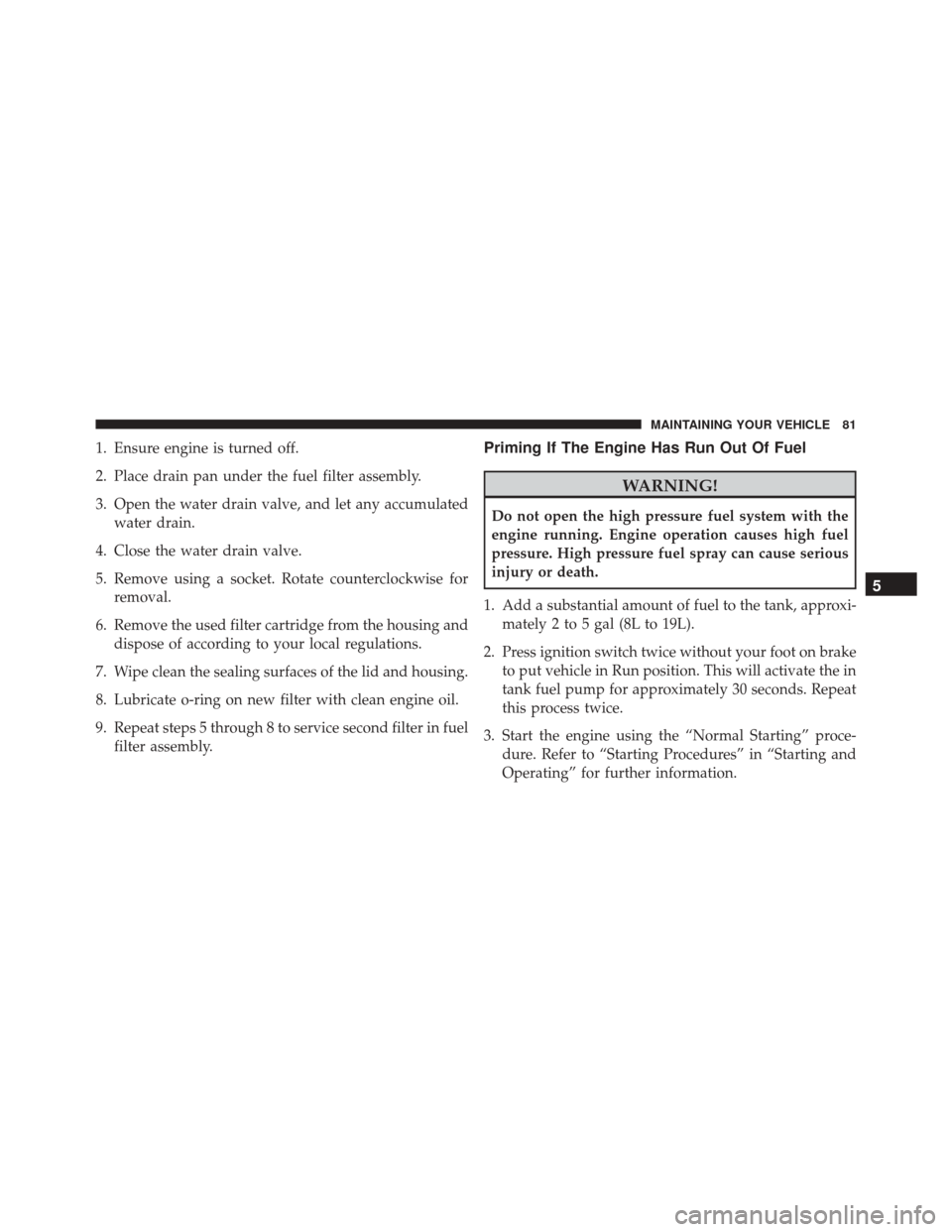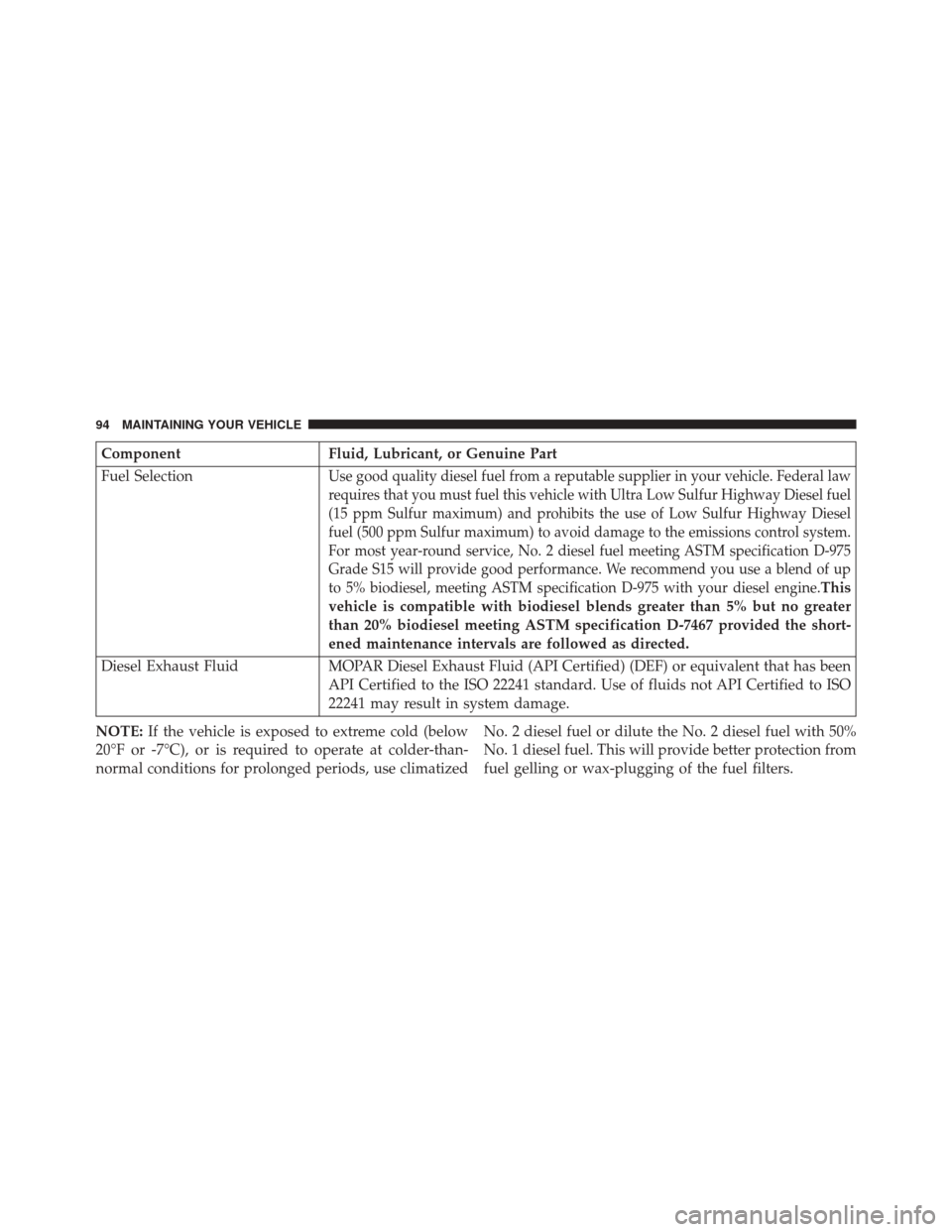Page 82 of 117
If more than two ounces or 60 milliliters of fuel have been
drained, follow the directions for “Priming If The Engine
Has Run Out Of Fuel.”
Underbody Mounted Fuel Filter Replacement
NOTE:Using a fuel filter that does not meet the manu-
facturer’s filtration and water separating requirements
can severely impact fuel system life and reliability.
CAUTION!
• Diesel fuel will damage blacktop paving surfaces.
Drain the filter into an appropriate container.
• Do not prefill the fuel filter when installing a new
fuel filter. There is a possibility debris could be
introduced into the fuel filter during this action. It
is best to install the filter dry and allow the in-tank
lift pump to prime the fuel system.
1 — Fuel Filter Access
2 — Water in Fuel Drain
Fuel Filter Assembly
80 MAINTAINING YOUR VEHICLE
Page 83 of 117

1. Ensure engine is turned off.
2. Place drain pan under the fuel filter assembly.
3. Open the water drain valve, and let any accumulatedwater drain.
4. Close the water drain valve.
5. Remove using a socket. Rotate counterclockwise for removal.
6. Remove the used filter cartridge from the housing and dispose of according to your local regulations.
7. Wipe clean the sealing surfaces of the lid and housing.
8. Lubricate o-ring on new filter with clean engine oil.
9. Repeat steps 5 through 8 to service second filter in fuel filter assembly.Priming If The Engine Has Run Out Of Fuel
WARNING!
Do not open the high pressure fuel system with the
engine running. Engine operation causes high fuel
pressure. High pressure fuel spray can cause serious
injury or death.
1. Add a substantial amount of fuel to the tank, approxi- mately 2 to 5 gal (8L to 19L).
2. Press ignition switch twice without your foot on brake to put vehicle in Run position. This will activate the in
tank fuel pump for approximately 30 seconds. Repeat
this process twice.
3. Start the engine using the “Normal Starting” proce- dure. Refer to “Starting Procedures” in “Starting and
Operating” for further information.
5
MAINTAINING YOUR VEHICLE 81
Page 84 of 117
CAUTION!
The starter motor will engage for approximately
30 seconds at a time. Allow two minutes between
cranking intervals.
NOTE: The engine may run rough until the air is forced
from all the fuel lines.
WARNING!
Do not use alcohol or gasoline as a fuel blending
agent. They can be unstable under certain conditions
and be hazardous or explosive when mixed with
diesel fuel.
CAUTION!
Due to lack of lubricants in alcohol or gasoline, the
use of these fuels can cause damage to the fuel
system.
NOTE:
• We recommend you use a blend of up to 5% biodiesel,
that meets ASTM specification D-975 with your diesel
engine. Use of biodiesel mixture in excess of 20% can
negatively impact the fuel filter’s ability to separate
water from the fuel, resulting in high pressure fuel
system corrosion or damage.
• In addition, commercially available fuel additives are
not necessary for the proper operation of your diesel
engine.
82 MAINTAINING YOUR VEHICLE
Page 94 of 117
FLUID CAPACITIES
U.S.Metric
Fuel (Approximate) 3.0L Diesel Engine 24.6 Gallons93.1 Liters
Diesel Exhaust Fluid Tank 8 Gallons30.3 Liters
Engine Oil With Filter
3.0 Liter Diesel Engine (SAE 5W-30 Synthetic, ACEA C3 Certified Low Ash) 8 Quarts
7.7 Liters
Cooling System
3.0L Turbo Diesel Engine (MOPAR Engine Coolant/ Antifreeze 10 Year/150,000 Mile Formula OAT (Organic Additive Technology)) 12 Quarts
11.4 Liters
92 MAINTAINING YOUR VEHICLE
Page 95 of 117
FLUIDS, LUBRICANTS AND GENUINE PARTS
Engine
ComponentFluid, Lubricant, or Genuine Part
Engine Coolant We recommend you use MOPAR Antifreeze/Coolant 10 Year/150,000 Mile
Formula OAT (Organic Additive Technology).
Engine Oil Only use ACEA C3 5W-30 Synthetic Low Ash engine oil meeting FCA Material
Standard MS-11106 or Pennzoil Ultra Euro L full synthetic 5W-30 motor oil.
Engine Oil Filter We recommend you use MOPAR Engine Oil Filters.
Fuel Filters We recommend you use MOPAR Fuel Filter. Must meet 3 micron rating. Using
a fuel filter that does not meet the manufacturers filtration and water
separating requirements can severely impact fuel system life and reliability.
5
MAINTAINING YOUR VEHICLE 93
Page 96 of 117

ComponentFluid, Lubricant, or Genuine Part
Fuel Selection
Use good quality diesel fuel from a reputable supplier in your vehicle. Federal law
requires that you must fuel this vehicle with Ultra Low Sulfur Highway Diesel fuel
(15 ppm Sulfur maximum) and prohibits the use of Low Sulfur Highway Diesel
fuel (500 ppm Sulfur maximum) to avoid damage to the emissions control system.
For most year-round service, No. 2 diesel fuel meeting ASTM specification D-975
Grade S15 will provide good performance. We recommend you use a blend of up
to 5% biodiesel, meeting ASTM specification D-975 with your diesel engine.
This
vehicle is compatible with biodiesel blends greater than 5% but no greater
than 20% biodiesel meeting ASTM specification D-7467 provided the short-
ened maintenance intervals are followed as directed.
Diesel Exhaust Fluid MOPAR Diesel Exhaust Fluid (API Certified) (DEF) or equivalent that has been
API Certified to the ISO 22241 standard. Use of fluids not API Certified to ISO
22241 may result in system damage.
NOTE: If the vehicle is exposed to extreme cold (below
20°F or -7°C), or is required to operate at colder-than-
normal conditions for prolonged periods, use climatized No. 2 diesel fuel or dilute the No. 2 diesel fuel with 50%
No. 1 diesel fuel. This will provide better protection from
fuel gelling or wax-plugging of the fuel filters.
94 MAINTAINING YOUR VEHICLE
Page 102 of 117
Required Maintenance
Refer to the Maintenance Schedules on the following
pages for required maintenance.
At Every Oil Change Interval As Indicated By Oil Change Indicator System:
•Change oil and filter.
• Completely fill the Diesel Exhaust Fluid tank.
• Drain water from fuel filter assembly.
• Rotate the tires. Rotate at the first sign of irregular wear, even if it occurs before the oil indicator system
turns on.
• Inspect battery and clean and tighten terminals as required.
• Inspect automatic transmission fluid if equipped with dipstick.
• Inspect brake pads, shoes, rotors, drums, hoses and park brake.
• Inspect engine cooling system protection and hoses.
• Inspect exhaust system.
• Inspect engine air cleaner if using in dusty or off-road conditions.
100 MAINTENANCE SCHEDULE
Page 104 of 117
Mileage or time passed (whichever comes first)
10,000
20,000
30,000
40,000
50,000
60,000
70,000
80,000
90,000
100,000 110,000
120,000
130,000
140,000
150,000
Or Years: 1 2 3 4 5 6 7 8 9 10 11 12 13 14 15
Or Kilometers:
16,000
32,000
48,000
64,000
80,000
96,000
112,000
128,000
144,000
160,000
176,000
192,000
208,000
224,000
240,000
Additional Maintenance
Drain water from fuel filter assembly. X X X X X X X X X X
Replace fuel filters and drain water from the fuel filter
assembly. XX X X X
Replace engine air filter. XX X XX
Replace the air conditioning filter. X X X X X X X X X X X X X X X
Flush and replace the engine coolant at 10 years or
150,000 miles (240,000 km) whichever comes first. XX
Replace accessory drive belt(s). X
Change transfer case fluid. X
102 MAINTENANCE SCHEDULE